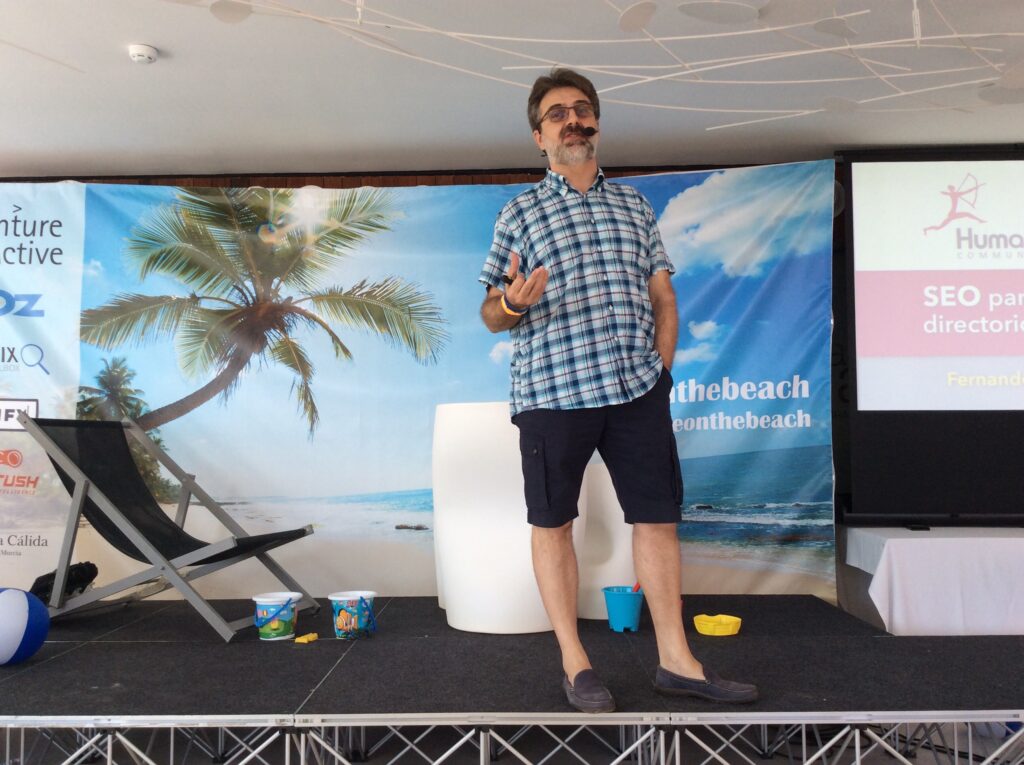Written by Fani Sánchez
Fernando Maciá(@fernandomacia) is director and founder of Human Level Communications. He is the author of several books on online marketing and web positioning and combines his profession with his teaching activity and his participation in lectures, conferences and round tables. In his presentation, Fernando Maciá presented a practical case of information architecture for a large web directory.
Directory information architecture
Fernando begins his presentation talking about information architecture as a great ally of SEO. Human Level’s experience in directories dates back to 2005, with Cantv, a directory similar to Argentina’s yellow pages.
The current model of telephone directories has become obsolete, since Google already incorporates call extensions, or very complete records in its Knowledge Graph that users use without having to enter the website. However, from the study and execution of the architecture for this directory, much has been learned and that is what he wants to share today at SEonthebeach.
The case study belongs to the brand Guías 11811. After the previous unsuccessful attempt with the corresponding predicted banning of the portal, it was migrated to 11811.es. This time, a proprietary database is used and iframes are discarded. Among 11811.es competitors we find 11870.com, paginasamarillas.es and qdq.es and this leads us to count on the following disadvantages:
- High bounce rate: these sites are designed to respond to very long tail queries. That is, the landing page that will receive me from search engines, I will find what I am looking for and leave the site.
- Same raw material as our competitors in terms of content and information
- Very low relevancy factors compared to our competitors: they were strong, older and more popular domains than the new 11811.es
In 2010, Yellow Pages was an unreachable domain, but QDQ and 11870 were fighting at more affordable levels, so they became our target. Based on these weaknesses, we identified the following opportunities:
- Increase 11811’s branding
- Smarter information architecture
- Increased speed and depth of indexing
- Improve on-page relevance, to provide something different from our competitors.
- Injecting popularity from “friendly” portals and reaching agreements with online media, partially commercializing the databases.
The portal scenario? 8,120 municipalities, 3,000 activities and 1.5 million business cards. Our goal was to cross municipalities with activities to position these listing pages, instead of focusing on company pages, whose content did not provide much more value than that of our competitors. The initial post-positioning objectives were:
- Generic and competitive keywords: lawyers in Madrid
- Long tail keywords more insurable: telepizza data, telephone El Corte Inglés Alicante
Problems #SEO of a large municipality + activity type directory structure, @fernandomacia at #seonthebeach.
– Ricardo Tayar (@rtayar) June 20, 2015.
Despite increasing the indexation by crossing (with head) activities and municipalities, not all pages could be visible (in terms of well positioned) in such a large website, so we will choose to enhance and optimize the pages that could generate more traffic.
Therefore, we placed above the fold the search engine, designed for users. And outside the above the fold, we help with a block of links to move up in the architecture the contents (crosses) with the highest traffic potential.
- We identified the nodes with the highest potential and shortened the distance in clicks to their pages using the link block.
- We concentrate the PR on the nodes with the links
- We work on the contents of these nodes
- To identify the most popular towns, we selected “super premium cities” and their populations.
- We select representative keywords to define the categories with the most potential and confirm their taxonomy by contrasting tools such as Keyword Planner.
In the most ideal case, it would take us 5 clicks to reach a company file via navigation. In another case, more common and with a non-optimized architecture, it could take up to 7 clicks to reach a company profile. With the optimized architecture, and largely by highlighting provinces, municipalities, categories and premium activities, we could reach the company profile in 3 clicks. These company files would participate more in the PR of the website, would be easier to index and more crawlable.
On the other hand, a reverse architecture was generated. If the main navigation route was to enter by location (provinces and municipalities) in the case of the reverse architecture we designed a navigation route with its corresponding landing pages for those who wanted to navigate starting by categories (activities).
A reverse navigation path is generated in the portal.
In this case, we must be careful with duplicate content, since it is very easy to reach the same crossings through both navigations. However, it was achieved while we were working on generating unique content.
Finally, in May 2012, we were above QDQ and 11870. Information architecture is always an ally to maximize and optimize the traffic of a directory, especially if it has a large volume of content.




